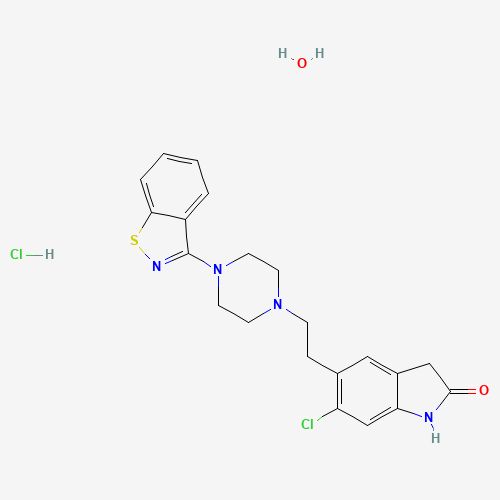| Pharmaceutical Information |
| Drug Name |
Ziprasidone hydrochloride monohydrate |
| Drug ID |
BADD_D02390 |
| Description |
Disorders such as schizophrenia and bipolar disorder can significantly impair mood, cognition, and behavior.[A190525] These mental illnesses can often be accompanied by comorbidities such as depression and substance abuse, and can significantly impact the quality of life of patients and caregivers.[A190525] Luckily, several treatment options for psychotic disorders have been introduced to market since the realization of chlorpromazine's antipsychotic properties in 1952.[A190525]
Second generation antipsychotics (commonly referred to as atypical antipsychotics) include [clozapine], [quetiapine], [olanzapine], [aripiprazole] and [ziprasidone] among others, and are generally thought to be as efficacious as first generation antipsychotics but differ in their adverse effect profiles.[A190525,A190534] First generation antipsychotics are associated with extrapyramidal adverse effects while atypical antipsychotics are linked to weight gain, impaired glucose tolerance and metabolic syndrome.[A190534,A190537]
Ziprasidone is used to treat schizophrenia and bipolar disorder.[A180748] It can effectively reduce the rate and time of relapses in schizophrenia, and can be used to treat manic episodes in bipolar disorder although the mechanism of action is unknown.[A180748] Although ziprasidone is classified as an atypical antipsychotic, it appears to have a lower incidence of metabolic adverse effects compared to other medications in the same class.[A190525] |
| Indications and Usage |
In its oral form, ziprasidone is approved for the treatment of schizophrenia, as monotherapy for acute treatment of manic or mixed episodes related to bipolar I disorder, and as adjunctive therapy to lithium or valproate for maintenance treatment of bipolar I disorder.[L7342] The injectable formulation is approved only for treatment of acute agitation in schizophrenia.[L7342] |
| Marketing Status |
approved |
| ATC Code |
N05AE04 |
| DrugBank ID |
DB00246
|
| KEGG ID |
D02100; D01939; D08687
|
| MeSH ID |
C092292
|
| PubChem ID |
60853
|
| TTD Drug ID |
D0R1JV
|
| NDC Product Code |
65841-157; 55111-890 |
| UNII |
216X081ORU
|
| Synonyms |
ziprasidone | ziprazidone | 5-(2-(4-(3-benzisothiazolyl)piperazinyl)ethyl)-6-chloro-1,3-dihydro-2H-indol-2-one | ziprasidone hydrochloride | CP 88059-01 | CP-88,059-1 | CP-88,059-01 | ziprasidone hydrochloride, monohydrate | Geodon | CP 88059 | CP-88,059 |
|
| Chemical Information |
| Molecular Formula |
C21H24Cl2N4O2S |
| CAS Registry Number |
138982-67-9 |
| SMILES |
C1CN(CCN1CCC2=C(C=C3C(=C2)CC(=O)N3)Cl)C4=NSC5=CC=CC=C54.O.Cl |
| Chemical Structure |

|
|
| ADRs Induced by Drug |
|
|
*The priority for ADR severity classification is based on FAERS assessment, followed by the most severe level in CTCAE rating. If neither is available, it will be displayed as 'Not available'.
**The 'Not Available' level is hidden by default and can be restored by clicking on the legend twice.
|
|
|

